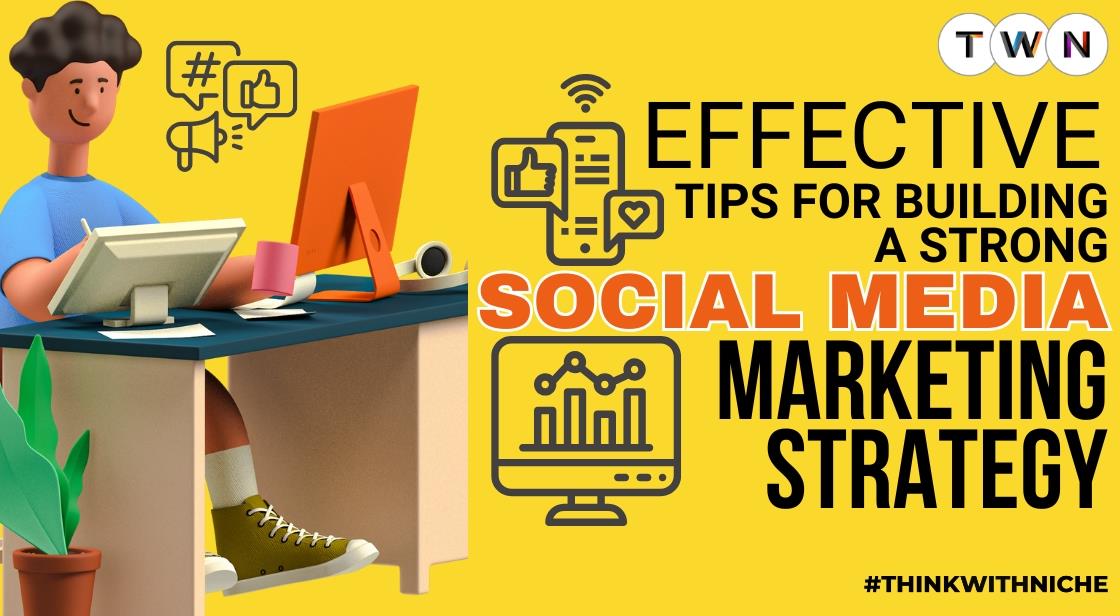Effective Tips for Building a Strong Social Media Marketing Strategy

Blog Post
In today’s digital landscape, social media marketing has emerged as a cornerstone of effective brand communication. With billions of users engaging on platforms like Facebook, Instagram, TikTok, and X (formerly Twitter), businesses have unprecedented opportunities to connect with their audiences.
However, simply being present on social media is not enough. To truly harness its potential, brands must adopt strategic approaches that resonate with their target audiences and drive meaningful engagement.
This blog delves into essential tips that can elevate your social media marketing efforts. From understanding your audience and optimizing content for each platform to leveraging analytics and experimenting with paid advertising, we will explore actionable strategies that can help you stand out in a crowded marketplace.
Whether you are a small business owner or a seasoned marketer, these insights will empower you to create compelling social media campaigns that not only capture attention but also foster lasting connections with your customers. Let’s dive in!
Tips to Elevate Your Social Media Marketing Efforts
What Is Social Media Marketing?
Social media marketing involves leveraging platforms like Facebook, Instagram, X (formerly Twitter), and TikTok to engage with your audience, increase brand visibility, and drive sales. It encompasses the creation of posts, images, and videos that resonate with your target audience, encouraging them to interact, share, and connect with your brand.
This approach takes advantage of the interactive nature of social media, enabling businesses to showcase their products while building a community around their brand. To create a successful social media marketing campaign, it’s essential to establish clear goals, select the appropriate platform(s), use analytics tools to measure performance, and adapt strategies as needed.
In contrast to traditional marketing methods—such as print ads, TV commercials, and billboards, which aimed to capture a wide audience—social media marketing offers a more personalized and targeted approach. The digital era has transformed marketing by allowing businesses to gather insights into user behavior, preferences, and online activities.
This data enables marketers to design campaigns that reach their intended audience more precisely. This shift towards personalization has revolutionized the way businesses interact with consumers, fostering more meaningful and targeted engagement.
Understand and Target the Right Audience
One of the foundational steps in a successful social media marketing strategy is thoroughly understanding and targeting the right audience. This ensures that your efforts are focused on engaging with the people who are most likely to benefit from and respond to your products or services.
Audience Research
Audience research is key to this process. It involves gathering and analyzing information about the demographics, psychographics, and behavior of your target audience. Demographics provide insight into age, gender, location, and income level, while psychographics reveal your audience’s interests, values, and lifestyle.
Behavioral data focuses on how your audience interacts with products or services, such as purchasing habits and social media activity. By combining these factors, you can identify key characteristics of your target audience, allowing for more personalized and effective marketing.
Persona Development
Creating detailed buyer personas is the next step. These personas are semi-fictional representations of your ideal customers, based on the data collected during audience research. Each persona should include specific traits such as their goals, pain points, preferences, and the social media platforms they use.
By developing these personas, you can tailor your social media content and campaigns to speak directly to the needs and interests of different audience segments, resulting in higher engagement and better outcomes.
Also Read: What is Social Listening and Why is it Important?
Social Listening
Social listening is a vital tool for staying connected to your audience’s evolving needs and preferences. By using social listening tools like Hootsuite, Sprout Social, or Brandwatch, you can monitor real-time conversations and trends on social media that are relevant to your brand or industry.
These tools help you gain insights into what your audience is discussing, their concerns, and their positive or negative feedback. This enables you to refine your strategies and engage more meaningfully with your target audience, ensuring your content remains relevant and impactful.
Optimize Content for Each Platform
Platform-Specific Content
Tailoring your content to fit the specific characteristics of each social media platform is crucial for success. Every platform has its unique audience and expectations when it comes to content style, tone, and format. For example, Instagram thrives on visually appealing images and short-form videos, while LinkedIn is more suited for professional and insightful content.
Twitter (now X) favors concise, direct communication with trending hashtags, while TikTok relies on engaging, bite-sized videos. Understanding these differences ensures that your content resonates with the intended audience on each platform, maximizing engagement.
Content Types
Different types of content perform better on different platforms. On Instagram and TikTok, short-form videos, reels, and stories are often highly engaging, while live streams are growing in popularity across Facebook, Instagram, and YouTube. Platforms like LinkedIn perform best with long-form articles, professional posts, and industry-related insights.
Meanwhile, images, infographics, and carousel posts tend to capture attention on Instagram and Pinterest. By diversifying your content—such as using a mix of videos, images, live streams, and interactive polls—you cater to the preferences of your audience, boosting interaction and visibility.
Consistency and Branding
Maintaining a consistent brand voice, style, and posting schedule across all platforms is key to building trust and recognition with your audience. Your brand’s tone should align with your company values and stay uniform, whether you’re posting on casual platforms like TikTok or professional ones like LinkedIn.
Additionally, a regular posting schedule helps keep your audience engaged and expecting your content. Consistency also ensures that your brand becomes more recognizable, building stronger brand loyalty. A consistent approach not only strengthens your brand identity but also helps in algorithmic performance, ensuring better reach across platforms.
Leverage Data and Analytics
Monitor Key Metrics
To measure the success of your social media marketing efforts, it's crucial to monitor key performance indicators (KPIs). These metrics provide valuable insights into how well your campaigns are performing and help identify areas that need improvement.
Some essential KPIs to track include reach (the total number of unique users who have seen your content), impressions (the number of times your content has been viewed), clicks (the number of times users have clicked on your links or posts), and conversions (actions that align with your goals, such as purchases or sign-ups).
By keeping an eye on these metrics, businesses can gain a deeper understanding of what resonates with their audience.
Using Social Media Analytics Tools
To streamline the process of tracking and analyzing these KPIs, businesses can leverage a variety of social media analytics tools. Platforms like Google Analytics allow businesses to monitor website traffic and conversion rates that come from social media channels.
Tools like Sprout Social provide comprehensive reports on audience engagement, content performance, and social media trends, while native platform analytics, such as Facebook Insights and Twitter Analytics, give specific performance data for each social media channel. These tools make it easier for marketers to track progress, identify trends, and make informed decisions.
Making Data-Driven Decisions
Data is key to optimizing social media strategies. Once you have gathered information from the analytics tools, it's important to use that data to adjust and refine your approach. For example, if certain posts are receiving more engagement than others, you can adjust your content to reflect those successful elements. Similarly, if a particular platform is outperforming others, you might focus more on that platform to boost results.
By consistently reviewing and acting on data, businesses can improve their social media performance, target their audience more effectively, and ultimately achieve better outcomes.
Engage with Your Audience Regularly
One of the key elements of a successful social media strategy is consistent interaction with your audience. By regularly engaging with your followers, you build stronger connections, enhance brand loyalty, and keep your audience interested in your content.
Engagement involves more than just posting updates—it includes actively responding to comments, direct messages, and mentions. Consistent interaction shows your audience that you value their input, fostering a sense of trust and belonging.
Why Engagement Matters
Responding to comments, messages, and mentions is crucial because it humanizes your brand and builds meaningful relationships with your audience. When you reply to their queries or acknowledge their feedback, followers feel valued and understood. This direct engagement can lead to increased trust, loyalty, and even word-of-mouth marketing. People are more likely to recommend a brand that they feel personally connected to, and engagement is the key to fostering that connection.
Host Q&A Sessions or Polls
One effective way to increase engagement is by hosting interactive sessions like live Q&As or polls. These activities encourage your followers to participate in real-time, providing an opportunity for them to ask questions, share their opinions, or provide feedback.
Live Q&A sessions can also give your brand a personal touch by showing the human side behind your business, while polls allow you to understand your audience's preferences and tailor content accordingly. This active involvement helps keep your audience engaged and creates a sense of collaboration.
Build Community
Authentic engagement is essential in creating a loyal community around your brand. When followers see that you consistently interact with them, they are more likely to feel like they’re part of a broader community. You can nurture this by regularly acknowledging your audience, providing helpful and relevant content, and encouraging conversations. Over time, this sense of belonging helps transform passive followers into an active, invested community, strengthening your brand's presence on social media.
Collaborate with Influencers and Partners
Collaboration is key to expanding your brand’s reach and enhancing its visibility. Let’s break down three effective ways to do this:
Influencer Marketing: Leverage Influencers to Reach a Wider Audience
Partnering with influencers allows your brand to tap into an already engaged audience. Influencers, who are seen as trusted voices in their respective niches, can promote your products or services to their followers, boosting your brand’s visibility and credibility.
The major benefit of influencer marketing is its ability to introduce your brand to new audiences in an authentic and engaging way. When you collaborate with influencers who align with your brand’s values, their endorsement feels organic and can significantly impact your brand awareness and sales.
Brand Partnerships: Collaborate with Complementary Brands for Cross-Promotion
Another strategic approach is forming partnerships with complementary brands. When you collaborate with a brand that shares a similar target audience but offers different products or services, both brands can benefit from cross-promotion. This collaboration can take the form of co-hosted events, joint social media campaigns, or product bundles.
By working together, both brands gain access to each other’s audience, helping you increase visibility, enhance credibility, and drive mutual growth without competing for the same customers.
User-Generated Content (UGC): Build Credibility and Trust with Customer Content
User-Generated Content (UGC) refers to content created by your customers, such as reviews, photos, or videos featuring your products. UGC is a powerful tool because it serves as social proof—when potential customers see real people enjoying your product, it builds trust and authenticity.
Encouraging your followers to share their experiences not only increases engagement but also gives you a wealth of content to repost and promote. By showcasing UGC, you demonstrate that people love your product, which can lead to higher conversion rates and strengthened customer relationships.
Collaborating with influencers, partnering with brands, and harnessing UGC are powerful strategies to boost your social media marketing efforts.
Experiment with Paid Advertising
The Role of Social Media Ads
Social media advertising is an effective way to expand your reach and engage with specific audience segments. Unlike organic content, which relies on your followers to share and engage with posts, social media ads allow businesses to target users based on demographics, interests, and online behaviors.
These ads can help amplify your brand’s visibility, bringing your products or services to the attention of a more relevant audience. With the ability to target people who are most likely to engage with your content, social media ads offer a powerful tool to boost both awareness and conversions.
Ad Formats
There are several popular ad formats available on platforms like Facebook, Instagram, and LinkedIn, each designed to capture attention in different ways. Stories ads, for example, appear between organic stories content and are great for short, engaging messages with a strong call-to-action.
Carousel ads allow businesses to showcase multiple products or features in a single ad unit, ideal for ecommerce or businesses with varied offerings. Sponsored posts appear natively within a user’s feed, blending seamlessly with organic content while subtly promoting your brand. These formats allow businesses to create tailored experiences that resonate with their audience.
A/B Testing
To make the most out of social media advertising, experimenting with A/B testing is crucial. A/B testing involves running different versions of ads—varying the creative elements, audience targeting, or ad copy—to see which performs better. For example, you might test different headlines, images, or targeting options (such as age or interest groups) to identify which combination delivers the best results.
By continually optimizing your campaigns through testing, you can improve engagement, increase ROI, and ensure your marketing budget is spent efficiently. Ultimately, this helps refine your approach and ensures you're using the most effective strategies to reach your goals.
Stay Up-to-Date with Trends and Algorithm Changes
In the fast-paced world of social media marketing, staying informed about the latest trends and algorithm changes is crucial for maintaining effective engagement with your audience. Here’s how you can adapt your strategy to keep up:
Adapting to New Features
Social media platforms regularly introduce new features that can enhance user experience and engagement. For instance, Instagram has rolled out features like Reels, allowing users to create short, engaging video content.
Similarly, LinkedIn has introduced Stories, enabling professionals to share quick updates in a more casual format. It's essential for marketers to keep an eye on these updates and integrate them into their content strategy. By leveraging these new tools, you can capture audience attention and improve interaction rates.
Algorithm Awareness
Understanding how algorithms work is vital for maximizing your content's reach and engagement. Social media algorithms determine what content appears on users’ feeds, often prioritizing posts that generate more interaction. When algorithm changes occur, they can significantly affect your content visibility. It’s important to monitor these changes and adjust your strategy accordingly.
For example, if an algorithm update favors video content over static images, consider shifting your focus to create more video-based posts to maintain or improve your engagement metrics.
Embrace Emerging Platforms
As new social media platforms emerge, it’s worth exploring their potential relevance to your target audience. Platforms like TikTok and Threads have gained significant traction and present new opportunities for marketers. Engaging with these platforms can help you reach younger demographics and diversify your marketing efforts.
However, always ensure that your chosen platforms align with your brand's values and your audience's interests. By embracing these emerging platforms, you can stay ahead of the competition and tap into fresh engagement opportunities.
By staying updated on trends and being adaptable, you can optimize your social media marketing efforts and effectively connect with your audience.
Why Social Media Marketing Is Important
Social media marketing has transformed the way businesses connect with their audiences. By providing real-time access to a global audience, it has replaced traditional marketing methods like billboards and radio spots. Here are some key reasons why social media marketing is essential for businesses today:
Increase Brand Awareness
Regularly posting on social media platforms significantly enhances brand visibility. This is particularly beneficial for small or newly established businesses looking to introduce themselves and their unique personality to a wider audience.
Drive Traffic
Engaging content combined with compelling calls to action can effectively drive traffic to your website. By incorporating targeted links in your posts, stories, or reels, you can guide users directly to your site. For instance, promoting a new blog post on X (formerly Twitter) with a “Read Now” button can attract followers to explore your website further.
Generate Leads
Social media platforms offer various lead generation tools, such as Instagram’s “Swipe Up” feature and LinkedIn’s lead-generation forms. If you’ve released a new e-book, for example, you can promote it on Facebook and include a direct download link in exchange for email addresses, allowing you to grow your email list.
Real-Time Discovery of Industry Trends
Social media serves as a dynamic platform for observing market trends and patterns. By monitoring trending hashtags and popular discussions within your industry, you can capitalize on viral topics and stay relevant.
Cost-Effective Marketing
Compared to traditional marketing channels like print and television ads, social media marketing can be much more affordable. In fact, you can engage in social media marketing for free if you lack a budget. Additionally, paid advertising options on platforms like Facebook, Instagram, and LinkedIn can help expand your reach without breaking the bank.
Humanize Your Brand
Consumers are drawn to brands that showcase authenticity. By sharing behind-the-scenes content or narrating your company’s story through posts and stories, you can create a more relatable brand image. For instance, Patagonia effectively highlights its commitment to environmental conservation, which resonates deeply with its customer base.
Conclusion
Effective social media marketing requires understanding your audience, optimizing platform-specific content, leveraging analytics, and engaging consistently. Collaborating with influencers, experimenting with ads, and adapting to trends and algorithms keep your strategy relevant and impactful, helping to build a loyal community and drive brand success in a dynamic digital landscape.
You May Like
EDITOR’S CHOICE












